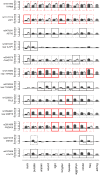Selectivity in genetic association with sub-classified migraine in women
- PMID: 24852292
- PMCID: PMC4031047
- DOI: 10.1371/journal.pgen.1004366
Selectivity in genetic association with sub-classified migraine in women
Erratum in
-
Correction: Selectivity in Genetic Association with Sub-classified Migraine in Women.PLoS Genet. 2015 Jun 15;11(6):e1005330. doi: 10.1371/journal.pgen.1005330. eCollection 2015 Jun. PLoS Genet. 2015. PMID: 26075714 Free PMC article. No abstract available.
Abstract
Migraine can be sub-classified not only according to presence of migraine aura (MA) or absence of migraine aura (MO), but also by additional features accompanying migraine attacks, e.g. photophobia, phonophobia, nausea, etc. all of which are formally recognized by the International Classification of Headache Disorders. It remains unclear how aura status and the other migraine features may be related to underlying migraine pathophysiology. Recent genome-wide association studies (GWAS) have identified 12 independent loci at which single nucleotide polymorphisms (SNPs) are associated with migraine. Using a likelihood framework, we explored the selective association of these SNPs with migraine, sub-classified according to aura status and the other features in a large population-based cohort of women including 3,003 active migraineurs and 18,108 free of migraine. Five loci met stringent significance for association with migraine, among which four were selective for sub-classified migraine, including rs11172113 (LRP1) for MO. The number of loci associated with migraine increased to 11 at suggestive significance thresholds, including five additional selective associations for MO but none for MA. No two SNPs showed similar patterns of selective association with migraine characteristics. At one extreme, SNPs rs6790925 (near TGFBR2) and rs2274316 (MEF2D) were not associated with migraine overall, MA, or MO but were selective for migraine sub-classified by the presence of one or more of the additional migraine features. In contrast, SNP rs7577262 (TRPM8) was associated with migraine overall and showed little or no selectivity for any of the migraine characteristics. The results emphasize the multivalent nature of migraine pathophysiology and suggest that a complete understanding of the genetic influence on migraine may benefit from analyses that stratify migraine according to both aura status and the additional diagnostic features used for clinical characterization of migraine.
Conflict of interest statement
The authors have declared that no competing interests exist.
Figures

Similar articles
-
Genome-wide-associated variants in migraine susceptibility: a replication study from North India.Headache. 2013 Nov-Dec;53(10):1583-94. doi: 10.1111/head.12240. Epub 2013 Oct 29. Headache. 2013. PMID: 24266335
-
Replication of migraine GWAS susceptibility loci in Chinese Han population.Headache. 2014 Apr;54(4):709-15. doi: 10.1111/head.12329. Epub 2014 Mar 25. Headache. 2014. PMID: 24666033
-
The NRP1 migraine risk variant shows evidence of association with menstrual migraine.J Headache Pain. 2018 Apr 18;19(1):31. doi: 10.1186/s10194-018-0857-z. J Headache Pain. 2018. PMID: 29671086 Free PMC article.
-
Deciphering the Role of the rs2651899, rs10166942, and rs11172113 Polymorphisms in Migraine: A Meta-Analysis.Medicina (Kaunas). 2022 Mar 29;58(4):491. doi: 10.3390/medicina58040491. Medicina (Kaunas). 2022. PMID: 35454329 Free PMC article. Review.
-
Genetics of migraine in the age of genome-wide association studies.J Headache Pain. 2012 Jan;13(1):1-9. doi: 10.1007/s10194-011-0399-0. Epub 2011 Nov 11. J Headache Pain. 2012. PMID: 22072275 Free PMC article. Review.
Cited by
-
Dopamine-beta-hydroxylase 19-bp insertion/deletion polymorphism affects medication overuse in patients with chronic migraine.Neurol Sci. 2019 Aug;40(8):1717-1724. doi: 10.1007/s10072-019-03865-9. Epub 2019 Apr 10. Neurol Sci. 2019. PMID: 30972508
-
Determination of the Frequency of Migraine Attacks in Pregnant Women and the Ways They Cope with Headaches: A Cross-Sectional Study.Healthcare (Basel). 2023 Jul 20;11(14):2070. doi: 10.3390/healthcare11142070. Healthcare (Basel). 2023. PMID: 37510512 Free PMC article.
-
A genetic risk score is differentially associated with migraine with and without aura.Hum Genet. 2017 Aug;136(8):999-1008. doi: 10.1007/s00439-017-1816-5. Epub 2017 Jun 27. Hum Genet. 2017. PMID: 28656458 Free PMC article.
-
AMG2850, a potent and selective TRPM8 antagonist, is not effective in rat models of inflammatory mechanical hypersensitivity and neuropathic tactile allodynia.Naunyn Schmiedebergs Arch Pharmacol. 2015 Apr;388(4):465-76. doi: 10.1007/s00210-015-1090-9. Epub 2015 Feb 10. Naunyn Schmiedebergs Arch Pharmacol. 2015. PMID: 25662185 Free PMC article.
-
Targeting TRP channels for novel migraine therapeutics.ACS Chem Neurosci. 2014 Nov 19;5(11):1085-96. doi: 10.1021/cn500083e. Epub 2014 Aug 29. ACS Chem Neurosci. 2014. PMID: 25138211 Free PMC article. Review.
References
-
- Bigal ME, Liberman JN, Lipton RB (2006) Age-dependent prevalence and clinical features of migraine. Neurology 67 (2) 246–251. - PubMed
-
- Stewart WF, Shechter A, Lipton RB (1994) Migraine heterogeneity. Disability, pain intensity, and attack frequency and duration. Neurology 44 (6 Suppl 4) S24–39. - PubMed
-
- International Headache Society (2013) The International Classification of Headache Disorders, 3rd edition (beta version). Cephalalgia 33 (9) 629–808. - PubMed
-
- Hansen JM, Baca SM, Vanvalkenburgh P, Charles A (2013) Distinctive anatomical and physiological features of migraine aura revealed by 18 years of recording. Brain 136 (Pt 12) 3589–3595. - PubMed
Publication types
MeSH terms
Grants and funding
LinkOut - more resources
Full Text Sources
Other Literature Sources
Medical
Miscellaneous

